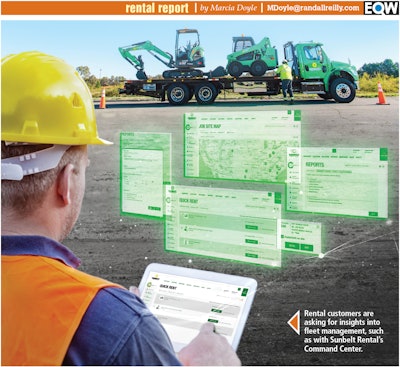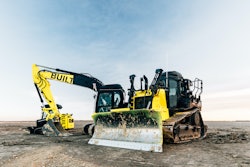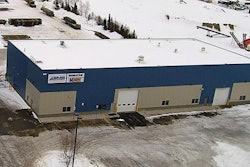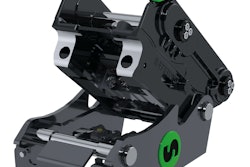
“We need to give our customers reliable equipment on time, ready to go, and in a way that helps them get their jobs done,” says Chris Hummel, chief marketing officer of United Rentals.
“There’s a huge structural shift, with users moving away from ownership into rental,” says John Washburn, senior vice president, marketing and sales, Sunbelt Rentals, “so if they’re not going to own it, it needs to be available when they call.”
It also needs to be easy to rent, whether that involves an online order or interaction with a sales representative. “Although human interactions will always be involved, we are transitioning to a digital age,” says Washburn.
Beyond basics
But rental customers want more than the basics these days; they want insight into how rental machines figure into their total fleet management, and rental companies are responding to the task.
“The idea is to use the equipment as effectively as possible, so they can rent as little as possible from us,” Hummel says. “That’s an odd thing for an equipment rental company to say, but we think that’s part of helping them do their job better.”
“Customers want to understand where their rented assets are located, their production costs and average fuel burns and idle time,” says Andy Grover, Cat’s digital product manager – rental and used. With all rental assets connected through Cat’s dealer network, the push is to support customers with telematic reports on these machines, a feature that will be available later this year on catrentalstore.com.
For some customers, it will be important to track the location of all rental machines positioned throughout several jobsites. “Let’s say you have a loader sitting on a jobsite and there is a new job starting five miles away,” Grover explains. “If there’s an opportunity to improve utilization on that asset, it may make sense to just move that machine instead of ordering another one.”
United’s Total Control system is designed to track a customer’s entire fleet – rented and owned – on multiple jobsites in real time. With the system, users can pinpoint equipment locations, streamline on and off renting and billing processes and use alerts to stay on top of everything. Users can customize reporting features and analyze key performance indicators and other statistics at a glance and access the information by web or phone.
Sunbelt’s online Command Center allows customers to see where their ordered equipment is in the delivery cycle. “In some cases, we know our customers’ rental habits better than they do themselves,” Washburn says. “And we’ve empowered our direct sales force with technology that allows them to provide real-time availability and pricing from their phones.” The ability to access the rental process through either a website or a mobile app is another customer request.
Command Center has been enhanced through the years to respond to customer requests for asset management tools. “They can see at any point exactly what’s on rent, how long it’s been on rent, and understand the utilization metrics,” Washburn says. This allows customers to manage their rental cycle from beginning to end. Other features include paperless invoicing, customized alerts, such as notifications when a purchase order has reached a threshold, and job-specific rental reports.
“Our customers’ projects are hard enough,” Washburn says. “We need to make equipment rental easy for them.”
Fingertip management
Customers are looking for the same kind of tools and experience they now get outside of the equipment world, Hummel says: “If they can track a pizza being delivered, how come they can’t get notification when their equipment is going to arrive?”
Sunbelt tracks customers’ recent and frequent orders, allowing them to reorder a preferred set of machines or tools, such as an air compressor/hammer/tooling package. “They don’t have to size up the compressor or count out the feet of hose or find three hammers,” Washburn explains. “They just choose the package and go.” Customers can also set up favorite orders.
The Cat Rental Store “My Account” portal, accessed online or through its mobile app, is designed to personalize a customer’s rental experience and data access. Launched in February, the feature gives customers quicker access to account information and expands what they can do online, including requesting a quote, calling off a rental machine, or requesting service 24/7.
“This gives customers improved access to their account information and the ability to export their own reports,” Grover says. “They want to understand their rental spend by jobsite, for instance.”
For contractors who work in several Cat dealer territories, the portal gives users a single log-in and easy navigation among customers’ accounts. “Through a click of a button, they have quick access to multiple accounts throughout our network,” Grover says.
Cat Rental Store’s mobile app allows users to log in and quickly view a menu that offers several options, such as requesting a machine or extending a rental. The app also allows them to see what they’ve got on rent, which contracts are ending soon and if anything is overdue. “It lets customers manage their accounts through one navigation screen,” Grover says.
United now has more than 250,000 assets tagged with telematic sensors, data it uses to offer a benchmarking service that lets contractors compare their rental utilization with other companies. “We probably have the largest fleet in the world; we have a good database of how people are using several brands of machines across multiple projects,” Hummel says. “By using these kinds of productivity measures, our customers can see a 20 percent reduction on their overall rental equipment spend.”
Companies can see benchmarks by the equipment type and industry vertical, such as nonresidential construction. “We compare their data by peer group in their industry vertical, and we’re starting to examine it by job type, so we can give them more contextual information,” Hummel says.
Addressing service pain points
One pain point the Cat Rental Store mobile app addresses is service calls, Grover says. The app allows users to take photos of the issue, add text and send it immediately to a Cat dealer. “This eliminates a back-and-forth call experience, which uses too much time and doesn’t track the progress of the request,” he says. The system also allows users to indicate whether it’s an emergency situation, and to directly call the dealer instead of using the photo/text route.
The app’s messaging feature allows a record of electronic communication with the dealer. Say, for example, you realize you really need a 36-inch bucket instead of a 24-inch bucket on the backhoe you just ordered. “Rather than going through the whole process to reorder the machine, you can simply use the messaging feature,” Grover says. “We’ve really sped up the communication with the dealer.”
“Our techs and drivers are the heroes in what we do,” says Sunbelt’s Washburn. “They use technology to diagnose what’s wrong, call up the schematics on an iPad, and they’re able to order parts from the field.”
The digital game in rental is just getting started, say our experts.
“If this was a baseball game, rental would be in the third inning,” Washburn says. “So there’s still a lot left to do.”













